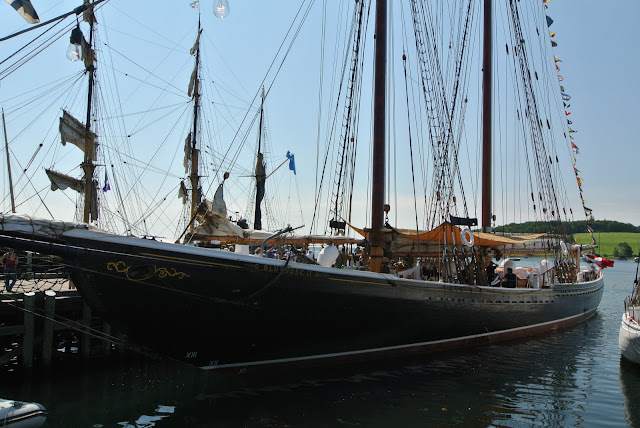A great
couple of bright warm days in Lunenburg to see some beautiful and perfect
examples of Tall Ships.
The event led by Sail Training International, Rendez-Vous 2017 Tall Ships Regatta which is a transatlantic race of race of 7000 nautical miles taking place over the course of five
months during 2017. The race starts at the port
of Royal Greenwich in Britain on April 13 and finishes in the port of Le Havre ,
France Portugal ,
Bermuda, the United States
and Canada
The tall ships are visiting Nova Scotia to honour the 150th anniversary of the Canadian Confederation. I addition to visiting Lunenburg, the ships will also visit 10 other Nova Scotia locations.
Below are photos of
some of the participants with and accompanying vignette ~
Bluenose II ~
The original Bluenose which was launched in March 1921 struck and sunk off a reef off at Isle aux Vache , Haiti
In 1963, Bluenose II was launched. It was built by many of the same people who had worked on the original vessel at the same shipyard in Lunenburg. The project was financed by Oland Brewery to advertise their products, while also promoting Nova Scotia Nova Scotia Nova Scotia
Theresa E.
Connor ~
Is the flagship of the Fisheries Museum of the Atlantic
in Lunenburg and permanent resident of the Lunenburg wharf. She is an
authentic reminder of an age of schooner fishing that lasted for almost one
hundred years in Atlantic Canada
The Picton Castle
registered in the Cook Islands is famous for
her World Circumnavigations. Built in as a Fishing Trawler in
1928, she served with the Royal Navy in WWII as a Minesweeper during which she
was known as the Liberator of Norway.
Lord Nelson ~
Lord Nelson
was the first tall ship in the world to be designed and built to enable people
of all physical abilities to sail side by side on equal terms. The keel of the ship was laid in October 1984 and
was later launched by HRH Prince Andrew and Sarah Ferguson on 4th July 1986. The ship generally sails around the United Kingdom, Western Europe, the Canary Islands and the Caribbean. During October 2012 to September
2014, the Lord Nelson sailed
around the world visiting 30 countries spanning all seven continents.
Europa ~
The Europa is a steel hulled barque registered in the Netherlands. Originally it was a German lightship named Senator Brockes, she was built in 1911 in Hamburg, Germany. Until 1977, it was in use by the German Federal Coast Guard as a lightship on the River Elbe. A Dutchman bought the vessel (or what was left of her) in 1985 and in 1994 she was fully restored as a barque, a three-mast rigged vessel, and retrofitted for special purpose sail training. Europa cruises worldwide and accepts paying voyage crew (trainees) for short or long trip segments, including ocean crossings, Sail Training Association races, annual voyages to Antarctica, South Georgia, Tristan da Cunha and Cape Town.
When and If ~
Built in 1939, When and If was commissioned by then Colonel George S. Patton, a widely regarded American war hero. She was constructed of double planked mahogany over black locust frames and an oak keel. Patton intended to sail the schooner around the world with his wife "when and if I return from the war", this phrase being the source of the yacht's name. Patton never fulfilled his dream after dying in a car accident in 1945 near Speyer, Germany, shortly after the end of World War II.
Bowdoin ~
The schooner Bowdoin built in 1921 in Maine, USA. She is the only American schooner built specifically for Arctic exploration, and was designed under the direction of Arctic explorer Donald B. MacMillan. She has made many trips above the Arctic Circle in her life. She is currently owned by the Maine Maritime Academy and is used for their sail training curriculum.
Wylde Swan ~
Wylde Swan is a fast sailing vessel originally built in Germany port of Makkum , Netherlands
The Spirit of Bermuda ~
The Spirit of Bermuda is a modern built Bermuda sloop, which is a type of small sailing ship built in Bermuda between the seventeenth and nineteenth centuries. Launched in August 2006 she is a purpose built training vessel.
St Lawrence II ~
The St. Lawrence II is a 72-foot brigantine designed for youth sail training and is operated by a crew of 14 to 18 year olds. The hull laid in 1953 in a Kingston, Ontario shipyard, with the rest of the ship finished by local craftsmen, Kingston sea cadets and enthusiastic amateurs. The St. Lawrence II's home port is Kingston, Ontario. The ship sails mostly in the Great Lakes and the St. Lawrence River but sometimes will venture as far as New York City.
HMCS Oriole ~
HMCS Oriole is the sail training vessel of the Royal Canadian Navy based at CFB Esquimalt in Victoria, British Columbia. She is a sailing ketch, currently the oldest commissioned vessel in the Royal Canadian Navy and also the longest serving commissioned ship. Originally the yacht Oriole IV, the vessel was first acquired by the Royal Canadian Navy during the Second World War then returned to private ownership at the war's end. Oriole IV was reacquired during the Cold War for use on the East Coast of Canada before switching to the West Coast of Canada permanently in 1956.

























































Beautiful pictures of all these boats reminds me of the Titanic
ReplyDeleteThe pictures of the Fall colours are amazing
ReplyDelete